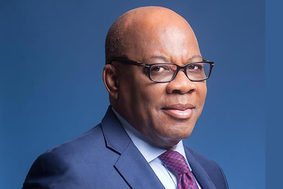U.S. tariff threats give China all the more reason to reform its auto sector

Feature Highlight
Beijing will take steps to consolidate the sector to strengthen domestic automakers and reduce overcapacity.
China's formidable but fragmented auto industry is ripe for a restructuring. As the world's largest auto producer, China now makes more cars than its market can handle. Yet China exports only a tiny fraction of the vehicles it produces, mostly to developing markets such as those in Iran and Vietnam because its cars primarily are lower-end vehicles and, with the exception of electric vehicles, Chinese brands still can't hold their own against the competition overseas. On top of these problems, China is under growing pressure from other countries, including the United States, to open its auto market to foreign brands and investors.
President Xi Jinping announced measures in part to address the U.S. demand, including lowering import tariffs and easing Beijing's 20-year-old restrictions on foreign ownership in the auto industry, in a speech at the Boao Forum in April. A few months later, the Chinese National Development and Reform Commission proposed a plan to correct overcapacity and promote industrial consolidation in the sector. The initiative aims to consolidate the Chinese automotive sector to make it more competitive as the United States pushes for greater access to the domestic market – and drives automakers elsewhere to look for new export destinations under the threat of increased U.S. tariffs. But the road to reform will be long and difficult.
The Big Picture
China is working to gradually open its auto market – just in time for the United States to pressure Beijing for greater market access and threaten higher tariffs on auto imports from its Asian, European and North American allies. The prospect of a more competitive environment under heightened U.S. pressure is pushing Beijing to pick up the pace in its attempts to consolidate the Chinese auto industry in a bid to shore up domestic brands and manage overcapacity.
Too Big to Thrive
Simply put, China's automotive industry is too big for its own good. Domestic consumption is showing signs of slowing after two decades of steady growth; since May, passenger vehicle sales have been down compared with last year. Production, on the other hand, is set to keep rising. The capacity under construction in 2017 could bring China's total annual production to 63.6 million conventional vehicles, more than double the current demand. Similarly, plans to expand electric vehicle manufacturing would put production at 6 million cars per year by 2020 – more than projected yearly sales for electric vehicles worldwide. 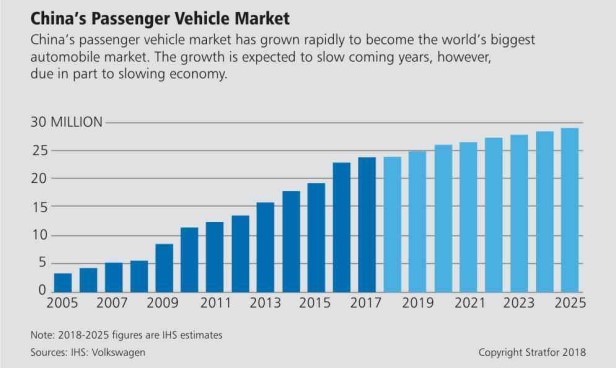
The overcapacity in China's automotive sector, like that in its steel or solar panel manufacturing industry, is a long-standing and multifaceted problem. More than in these other sectors, though, protectionist government policies and competing local and corporate interests have contributed to excess production capacity in auto manufacturing. Beijing made the automotive industry a pillar of its plans to industrialize China and to create internationally recognized Chinese brands. To that end, it has long nurtured and sheltered the sector with high tariffs (110 percent in 1994) and caps on imported vehicles. And when foreign automakers flooded in looking for investment opportunities in China, Beijing acceded, with a condition: Foreign companies would have to set up equal partnerships with Chinese automakers, mostly state-owned ones. The joint venture strategy, the central government hoped, would make the most of China's potentially lucrative market while helping local manufacturers to hone their skills and technology.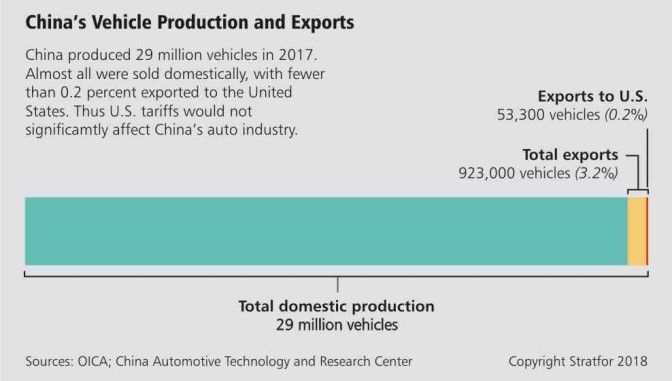
Diverging Goals
More than two decades later, the plan hasn't worked out quite as intended. The state-owned enterprises are still not competitive in the world market, or even the domestic one – private Chinese automakers such as Geely and Chery far outsell them in China. Most of their profits today come from their joint ventures with foreign companies instead of from their own brands. Meanwhile, Beijing's various protections for the companies – direct subsidies, investment into research and development, and tax incentives – have discouraged rather than fostered innovation. Worse yet for the central government, the joint venture program has united state-owned automakers, their foreign partners and their local governments against its desires to innovate and streamline the supply chain, initiatives that would threaten their interests.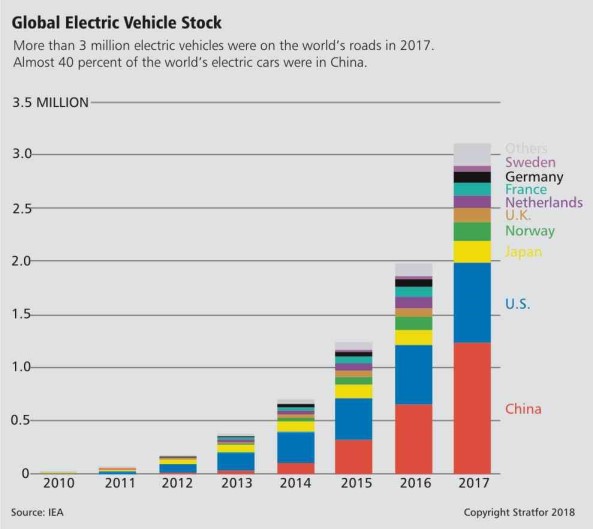
As China's auto industry has developed, the interests of local governments often have clashed with those of the central government. The priority for local leaders is to promote economic growth and protect jobs in their jurisdictions, even if doing so entails pouring money into subsidies and other programs to support automakers in the area. Some local governments offered electric vehicle manufacturers subsidies that covered the entire cost of production, a practice that enticed hundreds of companies to start producing electric cars. The result is a market in which supply far outpaces demand and a whole class of companies that depend on government support to survive. Though China is home to more automakers than anywhere else in the world – it has an estimated 184 traditional vehicle brands – its top 10 auto companies account for a whopping 87 percent of sales. Six of those firms are joint ventures with foreign companies. 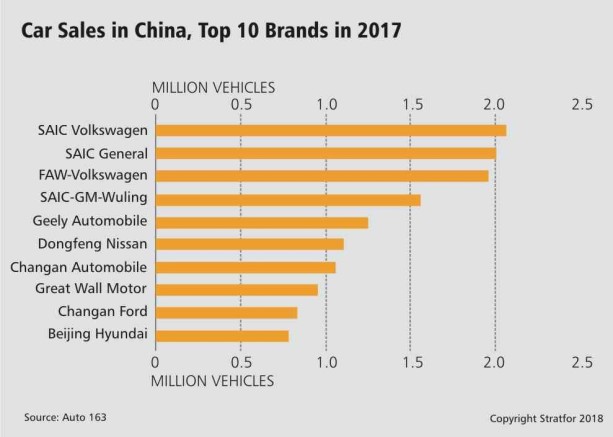
The Risks of Reform
China's central government has tried to pare down the unwieldy auto industry before, with mixed results. Several prospective mergers fell through because of objections from provincial governments or from the corporations involved, while the number of automakers kept on growing. Today, however, the internal and external factors weighing on the Chinese automotive sector have added new urgency to the reform initiative. The central government already has reduced its tariffs on imported vehicles (excluding those imported from the United States) and has also suggested that it will end its subsidies for electric vehicles by 2020. But the real challenge will be to create a more competitive domestic automotive industry by encouraging manufacturers to move up the value chain and innovate.
Of course, Beijing won't be able to realize its goals for the auto industry overnight. The central government is moving slowly to avoid inflicting too much pain on its domestic automakers at once, as the National Development and Reform Commission's proposal suggests. And even so, the process won't be easy. As Beijing forcibly closes inefficient and unprofitable automakers, workers will lose their jobs and local governments will express their dissatisfaction. Acquiring state-owned automakers, moreover, could undermine innovation at more profitable private companies and hurt their capacity. Finally, the consolidation could worry foreign firms wary of growing competition from China. But for Beijing, the risks of undertaking reform pale in comparison with the risks of failing to do so.
“U.S. Tariff Threats Give China All the More Reason to Reform Its Auto Sector” is republished under content confederation between Financial Nigeria and Stratfor.
Other Features
-
The best sites to buy and sell Bitcoin in Nigeria: A comprehensive ...
Buying and selling BTC doesn’t have to be a hassle. Check out to best sites to buy and sell Bitcoin in Nigeria ...
-
At 50, Olajide Olutuyi vows to intensify focus on social impact
Like Canadian Frank Stronach utilised his Canadian nationality to leverage opportunities in his home country of ...
-
Reflection on ECOWAS Parliament, expectations for the 6th Legislature
The 6th ECOWAS Legislature must sustain the initiated dialogue and sensitisation effort for the Direct Universal ...
-
The $3bn private credit opportunity in Africa
In 2021/2022, domestic credit to the private sector as a percentage of GDP stood at less than 36% in sub-Saharan ...
-
Tinubunomics: Is the tail wagging the dog?
Why long-term vision should drive policy actions in the short term to achieve a sustainable Nigerian economic ...
-
Living in fear and want
Nigerians are being battered by security and economic headwinds. What can be done about it?
-
Analysis of the key provisions of the NERC Multi-Year Tariff Order ...
With the MYTO 2024, we can infer that the Nigerian Electricity Supply Industry is at a turning point with the ...
-
Volcanic explosion of an uncommon agenda for development
Olisa Agbakoba advises the 10th National Assembly on how it can deliver on a transformative legislative agenda for ...
-
Nigeria and the world in 2024
Will it get better or worse for the world that has settled for crises?
Most Popular News
- NDFF 2024 Conference to boost Nigeria’s blue and green economies
- IFC, partners back Indorama in Nigeria with $1.25 billion for fertiliser export
- CBN increases capital requirements of banks, gives 24 months for compliance
- CBN settles backlog of foreign exchange obligations
- Univercells signs MoU with FG on biopharmaceutical development in Nigeria
- Ali Pate to deliver keynote speech at NDFF 2024 Conference








